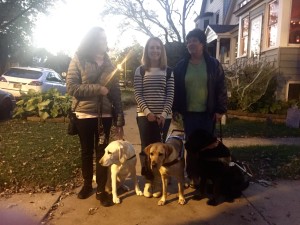Many of you who follow Doublevisionblog on Facebook see all of Roja’s updates, but for those who aren’t Facebook fans, here are a couple recent posts and pictures that include Roja.
December 1st, 2015
December 1st started out rough for Roja’s household, beginning with an ER visit at 1:30am after months of my 9-year-old’s off-and-on stomach issues culminated into a scary mess. Fearing appendicitis, after talking to Lucy’s doctor, my husband took her in while I stayed with our sleeping 5-year-old. Not able to sleep, I paced the house and finally knelt on my knees in my bedroom. Updates from Ben were scarce, and I finally called his cell in desperation, just to hear my baby screaming hysterically in the background as the nurses poked her for the 8th time trying to find the right vein for the IV. I quickly hung up the phone and sobbed, wanting to be there with her and also not wanting to hear or know any of it. My nerves got the best of me and my body began shaking uncontrollably.
And that’s when I heard the whack of a tail inside the dog crate next to me. Realizing Roja was awake, I opened the crate and she ran out and nuzzled into me with the fiercest hug she has ever given me. The time was 4am and the people in my life who would normally bring words of comfort were all sleeping, so my nerves were calmed by wags of comfort instead. I was able to doze off for several minutes before the next update. CT scan showed no inflammation near the appendix and the IV was replenishing fluids. Of course, in true ER fashion, the full test results took hours to come in and she wasn’t released until late morning.
So this morning Roja and I set off on our 5 block walk to Walgreens for homecoming supplies, aided by my favorite 5-year-old helper who had convinced me to keep her home from school to wait for big sissy. Our main mission was carpet cleaner and more paper towels to help with the scary mess, as well as soup and jello. As we walked back with our small load of supplies, Roja turned at the wrong curve on the river walk, and I at first reprimanded her. But then my 5-year-old pointed out that we were right in front of a manger scene decoration that our town had just put up. I knelt down with my Walgreens bag and gave Roja a pat. I was reminded that, even on hard days like this, when you’re just a helpless mom who doubts her actions and has no idea how to help her sick child, there are still small moments to be thankful for.
I used to think my new companion was placed in my life solely to be my eyes, but I am beginning to realize that it’s more than that. Roja leads me to the important things that I tend to forget about when I’m consumed with my own worries and sorrows, like the upcoming holiday and the hope and love that it brings. That little glimpse of gratitude and hope gave me what I needed to greet Lucy, as she returned home with her battle wounds, ready to tell me her war stories while holding up her bandaged arms and hand. I could confidently face her and say, “Sweetie, we still have no idea what’s going on with that tummy of yours, but we will figure it out and get you back to your happy, healthy self.”
P.S. I can tell Lucy is truly my daughter when, between bouts of pain, she is busily writing a story about her trip to the hospital for a school assignment tomorrow. #thatsmygirl








